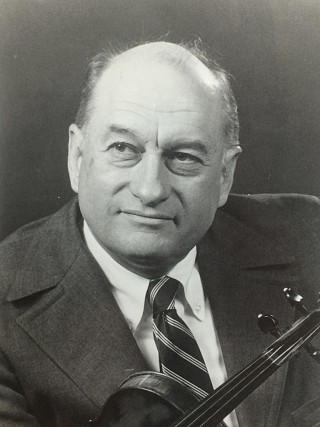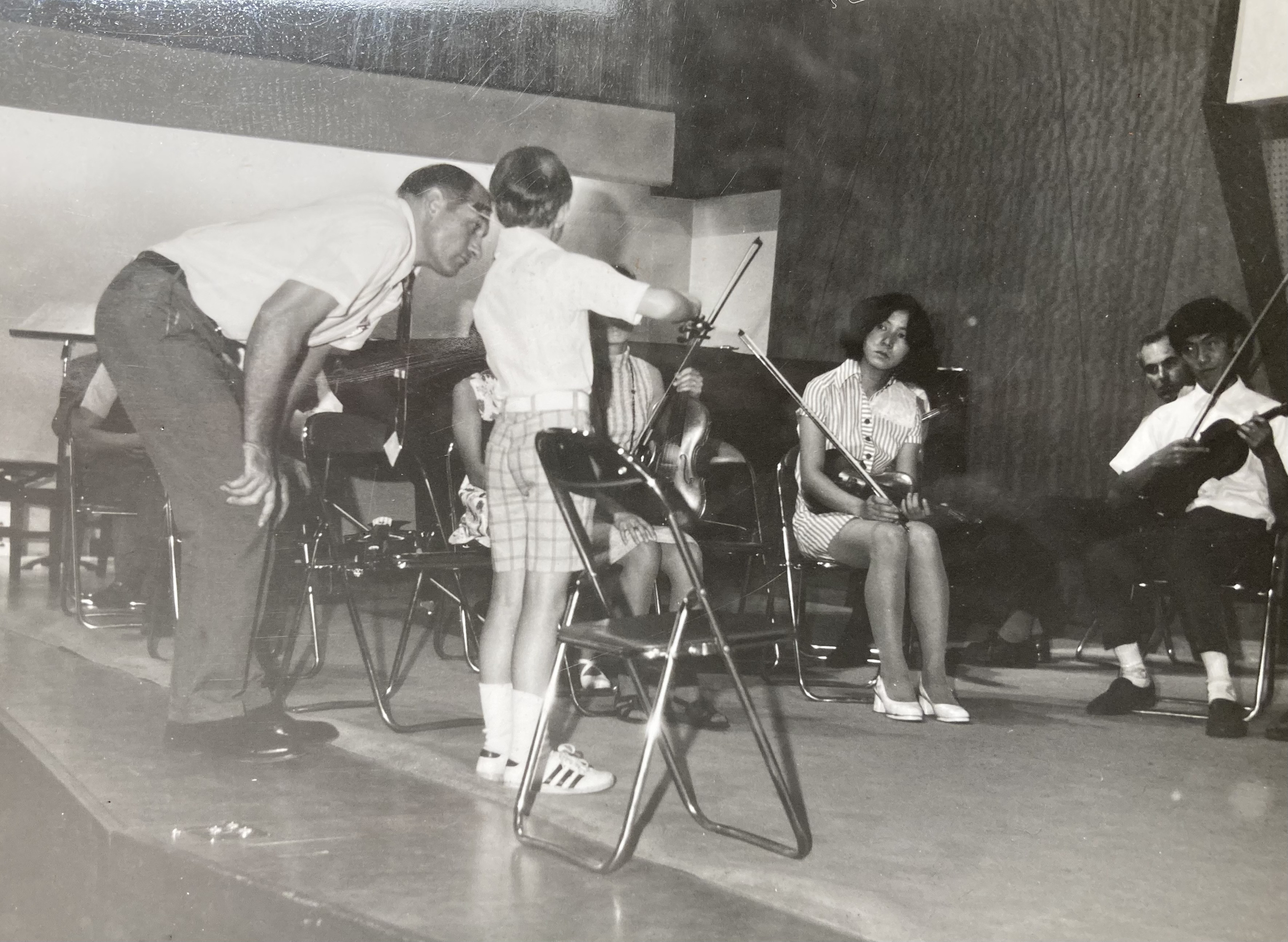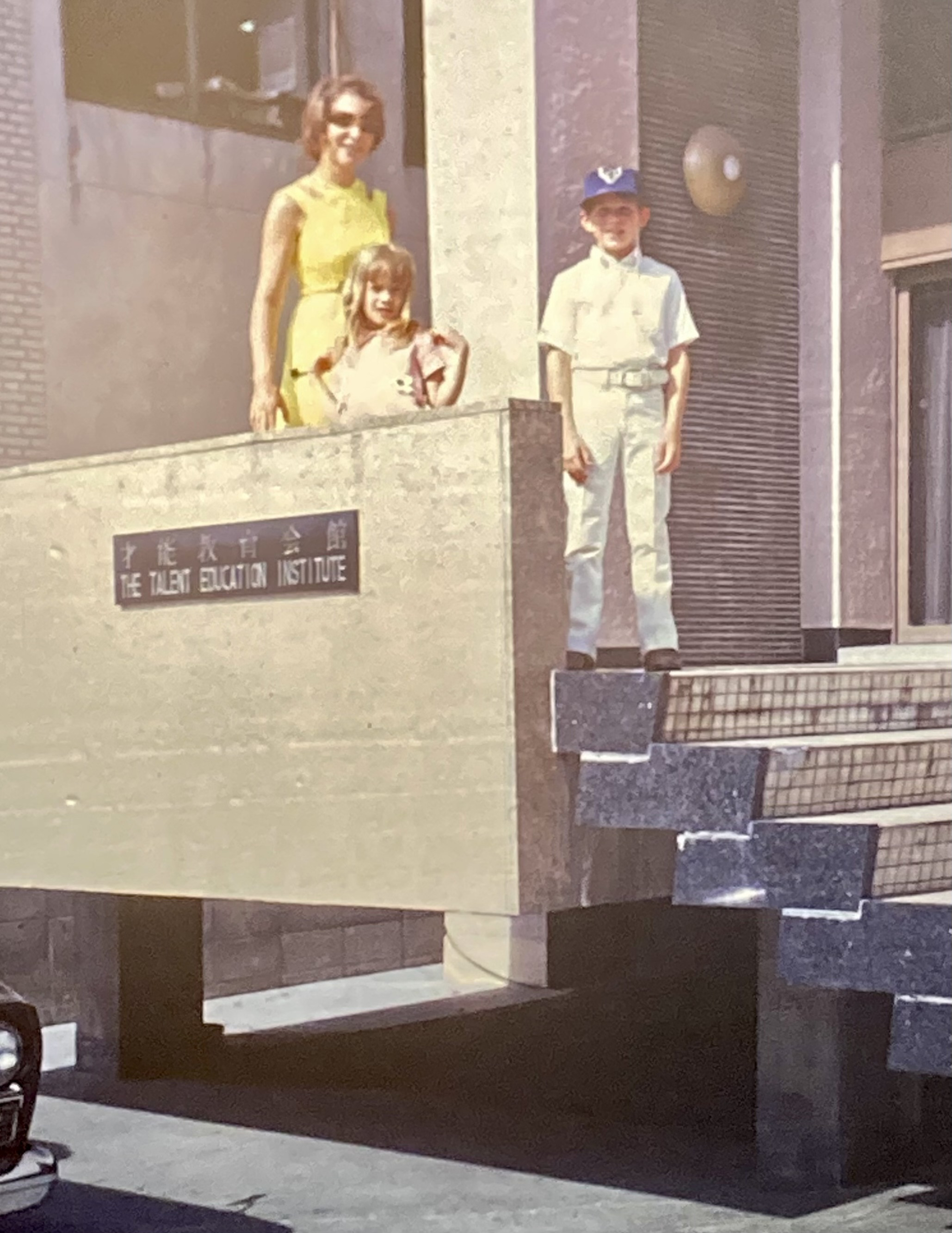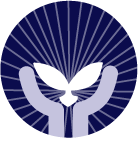Lacy McLarry

Lacy McLarry, a Texan by birth, started the study of violin at the age of five, performing the Mendelssohn Concerto for Violin with the Houston Symphony at age 14. His teacher was Philip Williams, with whom he studied from the age of eight through the completion of Bachelor and Master of Music degrees from Southern Methodist University in Dallas. He originally joined the Oklahoma Symphony Orchestra in 1958, following three and one-half years of active duty as a Naval Officer aboard the U.S. Shangri-La. He then served on the faculty of Kansas State Teachers College in Emporia, where he began his well-known Suzuki program. During the summers Lacy was Concertmaster of the New Hampshire Music Festival. In 1972 he returned to Oklahoma as Concertmaster of the Oklahoma Symphony Orchestra (now the Oklahoma City Philharmonic), and as Artist-in-Residence and Director of String Development at Oklahoma City University, where he developed his highly successful Suzuki program involving several teachers and hundreds of pupils ranging in age from two to twenty years. In 1983, the Honorable Governor George Nigh and the Oklahoma Federation of Music Clubs presented the “Oklahoma Musicians of the Year” award to Lacy and Beverly McLarry.
Lacy and his wife, Beverly, are retired and living in Oklahoma City. Beverly has had a long career in vocal music and as a composer. Their son, Royce, is presently Principal Violist in the Oklahoma City Philharmonic; and their daughter, Amanda, is director of the Suzuki Academy of Waco and a Suzuki Teacher Trainer with over forty years of teaching experience.
Other Places you have lived since Japan: Emporia, Kansas; Norman, Oklahoma
Instrument studied in Japan: Violin
Dates in Japan: Summer of 1971
Years and locations of workshops with Dr. Suzuki that were outside of Japan: 1965, Oberlin Conservatory; 1966 and 1968, Kansas State Teachers College of Emporia; 1978 San Francisco; 1979 Munich, Germany
Memories
Lacy McLarry’s Introduction to the Teaching of Shinichi Suzuki
Dr. B.A. Nugent, Music Department Head at Kansas State Teachers College (KSTC), and I had been discussing the need for a new approach to building string programs in schools or in private teaching. This was in 1964, and it seemed to us that there was less interest in the playing or study of string instruments in America than ever before. So, Vergil Person, my colleague at KSTC, and I were fortunate enough to attend a concert in Wichita by the Suzuki Performance Group on their first Tour of America – standing room only, and what a performance it was! Children from five years old to thirteen – playing such things as Bach’s Concerto for Two Violins, La Folia, and Sicilienne and Rigaudon by Kreisler.
Our fortuitous trip from Emporia to Wichita to hear the tour group convinced me that interest in string playing could be developed. Dr. Nugent encouraged me to look into it.
So — I was scheduled to teach for six weeks of summer school at KSTC (1965) when I learned that Dr. Suzuki was doing a three-week workshop at Oberlin College, and Clifford Cook, the head of the Oberlin Suzuki program, allowed me to squeeze into the third week. Thus, I made a whirlwind trip to Ohio after my summer teaching was over.
That week was a delight: Dr. Suzuki’s schedule was very relaxed – lessons all morning, with a smoking break mid-morning (for Dr. Suzuki), and Dr. Suzuki explaining what he was doing and why. Now, please look at the following list!
- Everything memorized
- Begin as young as possible
- Repetition (“10,000 times”)
- Parent attends lesson, and parent teaches child at home
- All learn same repertoire so they can play together and for each other
- Tone, tone, tone! (Tonalize)
- Other students and parents present at lesson (master class)
- Listening
- One point Lesson
- Master each step or piece before going on
- Teacher demonstrates
- Teaching style, technique, and musicianship together – not as separate studies
- Talent can be developed through education (Talent Education)
These points are not meant to be a complete list of actions or insights that would comprise the Suzuki Method, but are some of the ideas and techniques of Dr. Suzuki which to some degree were also part of the teaching ideas used by my great teacher and violinist, Philip A. Williams, as I grew up working with him from age 8 through a Masters Degree at Southern Methodist University. Therefore, the teaching that I was fortunate to receive during my school years seemed to fit Suzuki’s ideas like “hand in glove.” I could use Dr. Suzuki’s ideas with enthusiasm, and without reservation.
So, we decided (Dr. Nugent and I) that the Suzuki system was the right choice. We talked with a few parents with small children and began their study in time to have Dr. Suzuki come for a one-week workshop in 1966, and a one-week workshop in 1968 at KSTC.
I think that the results showed that this was a successful project, and that good teaching practices work all over the world.
In 1971, after teaching several years in our Suzuki program, I determined that a trip to Japan was called for. It seemed advisable to check out the teaching and methods of Talent Education with Dr. Suzuki to see if we understood it as clearly as we thought we did, as practiced in Matsumoto and throughout Japan.
So, our family of four (wife Beverly, children Royce and Amanda – ages 8 and 6, and myself) set out for Matsumoto, Japan.
I will not try to detail the events of the summer, but I will tell a few stories that show some of the warmth generated by Dr. Suzuki in his dealings with children and adults alike:
We arrived in Yokohama after a two-week cruise on American President Ship, S.S. Cleveland. One night at Yokohama Hotel seemed very expensive, so I called Mrs. Suzuki to let her know that we were coming right away to Matsumoto by train—and the time of arrival. We arrived in Matsumoto, and at the station to meet us were Dr. and Mrs. Suzuki plus others from Talent Education Institute, with two cars (one of them the Suzuki’s, driven by Mrs. Suzuki).
They drove us to the Utsukushigahara Onsen Hotel, checked us in, and took us to dinner at the hotel dining room. At dinner, Dr. Suzuki introduced Royce and Amanda to “potage” (a tasty soup), to make these “Western children” feel at home in Japan.
During dinner Dr. Suzuki proposed that I visit his studio the next morning to observe a lesson which he thought I might find “interesting.” So, naturally I thought this would be a great way to start my observations. It turned out that this lesson was with a little 13-year-old girl who had lost her teacher. Dr. Suzuki had finally agreed to teach her, although he no longer taught individual lessons. By now he was spending his regular teaching time with teacher training. I think that this must have been a very high honor for her.
Well, “interesting” is not half of it. The girl was having a lesson on the Bach Ciaccona. Her playing was superb, and the lesson she got with Dr. Suzuki was beautiful in every way, both musically and technically.
One day Dr. Suzuki suggested that Royce and Amanda play a recital. They would choose three or four pieces each and would play on the Talent Education Institute stage. They were a little nervous, of course, wanting their performance to be at the highest level that they could muster. The practice increased in amount and intensity. Some time went by – two or three weeks, I think. Suddenly, Dr. Suzuki asked me if my children were present and ready to play the recital. Of course, I said they were. Royce and Amanda thought that Dr. Suzuki might have forgotten about the recital, but not Suzuki! So, at the appointed time we went into the auditorium, and the recital, accompanied by Dr. Kataoka at the piano, was successfully done.
As our time in Japan came rushing to a close, we continued our observation of individual lessons, group lessons, and recitals performed by students of the master teachers of Japan. I visited Dr. Suzuki’s studio almost daily, listening mostly to lessons of the teacher trainees.
To finish our seven-week stay in Japan we made our way back to Yokohama to board our cruise ship for a return trip to the U.S. of A.
So, our adventure to Japan and the study of the Suzuki Method, up close and in depth, leads me to believe that we do have a good understanding of the system.
Thank you, Dr. Suzuki, for sharing your ideas with us.
Photos in Matsumoto, 1971

Lacy McLarry demonstrating vibrato for kenkyusei with son Royce (age 8)

Lacy McLarry (standing), Royce McLarry (age 8), Dr. Suzuki and kenkyusei during a vibrato demonstration in Matsumoto

Lacy McLarry working with Royce in a vibrato demonstration

Lacy McLarry, son Royce, and Dr. Suzuki during a vibrato demonstration

Mr. McLarry’s children, Royce (age 8) and Amanda (age 6) in Matsumoto

Mr. McLarry’s wife, Beverly, and children Royce and Amanda, at the Talent Education Institute

